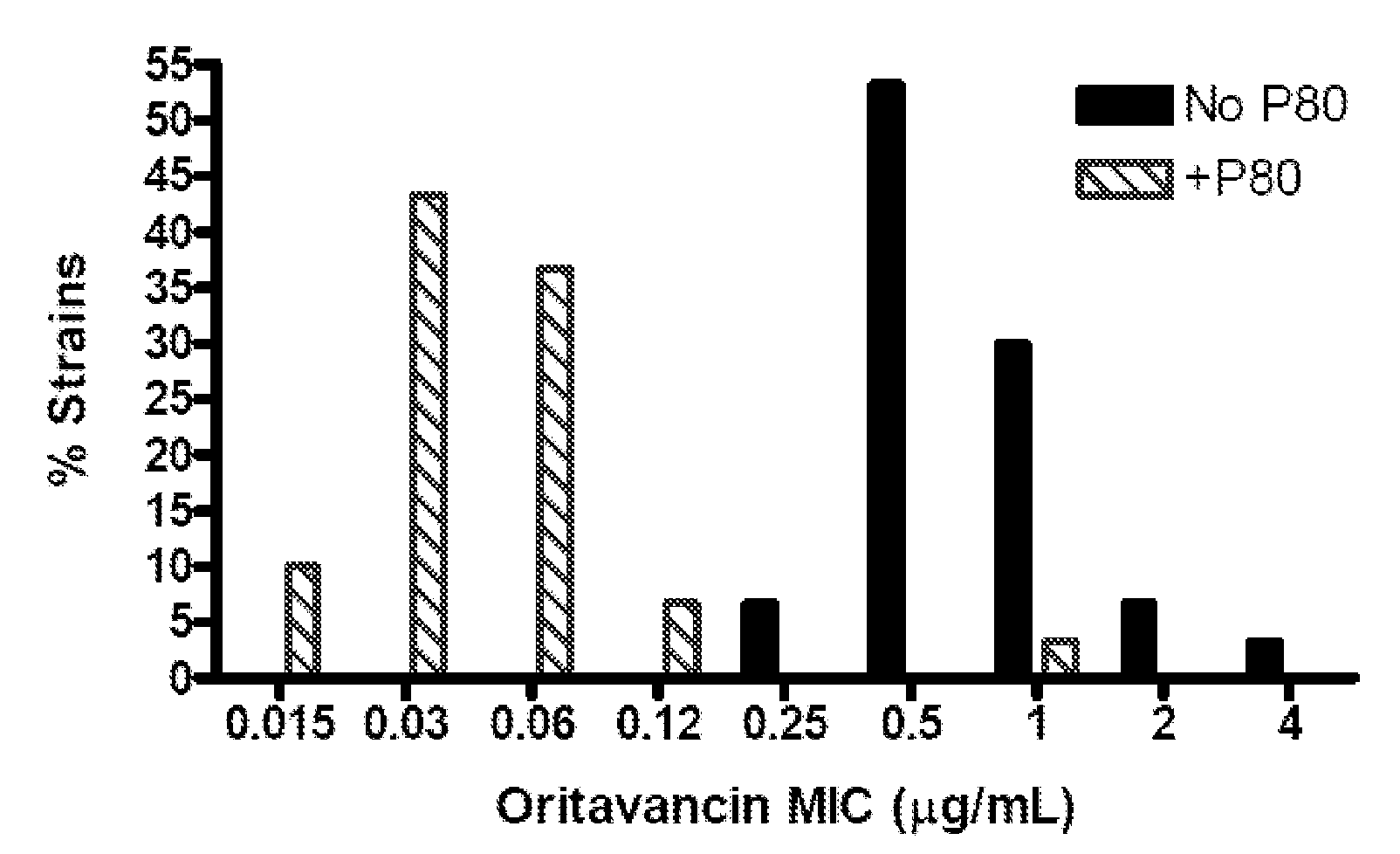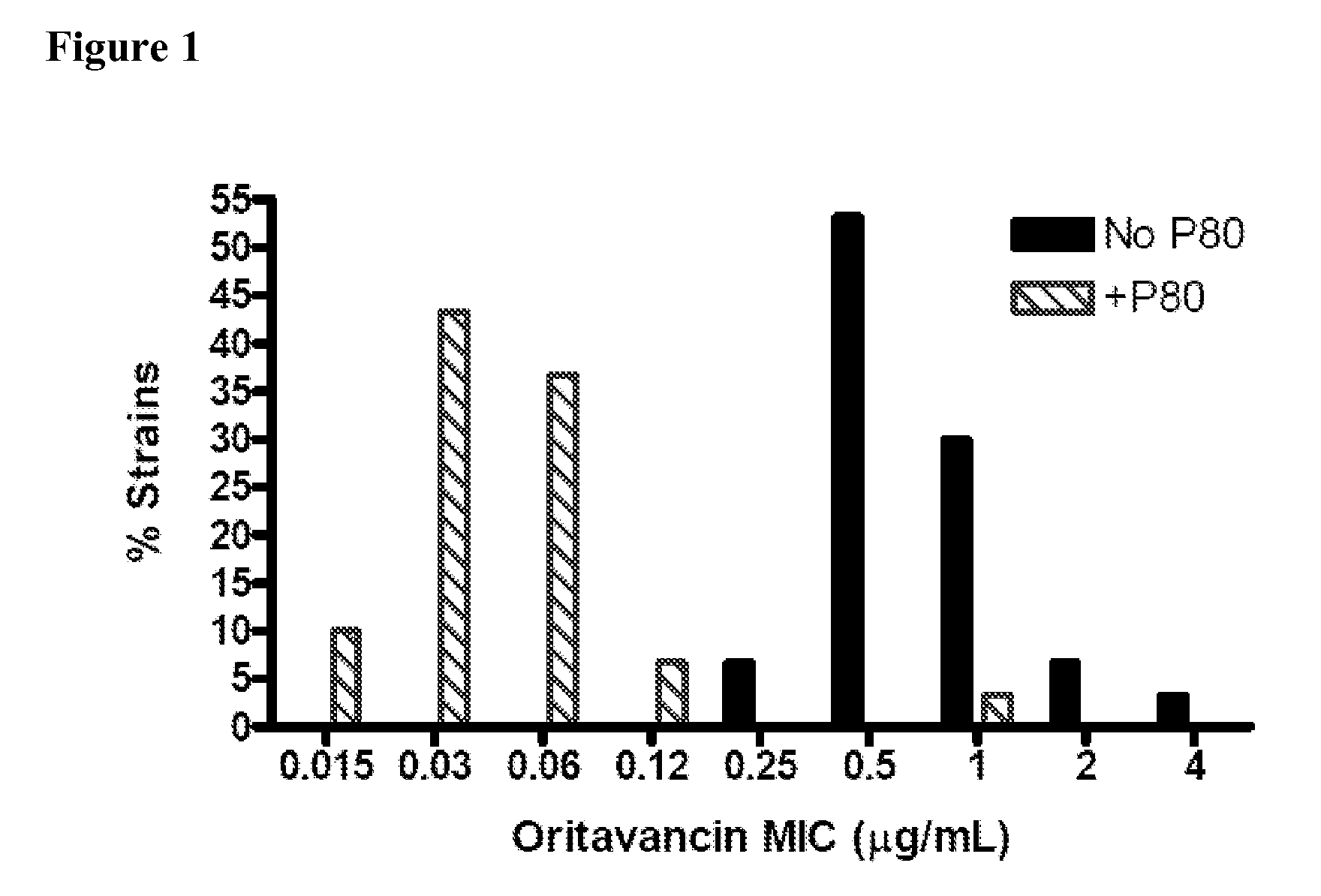Use of oritavancin for prevention and treatment of anthrax
an anthrax and oritavancin technology, applied in the direction of antibacterial agents, peptide/protein ingredients, saccharide peptide ingredients, etc., can solve the problems of prolonged delay before initiation of therapy, high mortality of exposed individuals, and inability to cure, so as to inhibit the colonization of a subject
- Summary
- Abstract
- Description
- Claims
- Application Information
AI Technical Summary
Benefits of technology
Problems solved by technology
Method used
Image
Examples
examples
[0255]Demonstration of activity of an antibacterial agent, such as a glycopeptide antibiotic, in an animal model is of significant impact to the identification of doses and dose regimens that would provide effective therapy in humans because phase II and phase III clinical trials (on anthrax-infected patients) cannot be conducted for ethical reasons. As such, studies with anthrax-infected animals are critical to approval of agents for anthrax chemotherapy (“Two Animal Rule”, Federal Register. 2002. Fed. Regist. 67:37988-37998; and Guidance for Industry. Inhalational Anthrax [Post-Exposure]—Developing Antimicrobial Drugs. CDER March 2002).
[0256]Likewise, characterization of the in vitro activity of an antibacterial agent, such as a glycopeptide antibiotic, against representative bacterial isolates is an important step in predicting whether an antibiotic dose and dose regimen that are efficacious in animals infected with a single test strain may be expected to provide a therapeutic be...
experiment 1
Susceptibility of B. anthracis Strains to Oritavancin as Measured by Broth Microdilution
[0257]Broth microdilution minimum inhibitory concentrations (MICs) were determined for oritavancin against a challenge set of 30 B. anthracis strains, including the Ames strain, from the USAMRIID collection. These strains were isolates from human or animal infections throughout the world and represent the eight genotype clades identified by Keim (Keim et al. 2000. J. Bacteriol. 182:2928-2936). MICs for comparator antibiotics ciprofloxacin and vancomycin were determined in parallel.
[0258]MICs were determined by the broth microdilution method in 96-well plates according to guideline M7-A7 of the Clinical and Laboratory Standards Institute (Clinical and Laboratory Standards Institute (CLSI). 2006a. Methods for Dilution Antimicrobial Susceptibility Tests for Bacteria That Grow Aerobically; Approved Standard—Seventh Edition. CLSI document M7-A7 (ISBN 1-56238-587-9); Clinical and Laboratory Standards I...
experiment 2
Oritavancin Pharmacokinetics and Dosing Determinations
[0263]The intravenous (i.v.) route of administration has been used for oritavancin in all clinical trials to date. However, because multiple doses of the test and control agents are often required during therapy in the mouse model of inhalation anthrax, the i.p. route is the most convenient route of administration since multiple i.p. administrations of test agent and comparators are generally well-tolerated by the animal. A pharmacokinetics (PK) study was therefore performed in mice to compare oritavancin exposure in plasma following administration of a single dose of oritavancin by the i.v. and i.p. routes.
[0264]All in vivo studies were performed in accordance with guidelines set by the USAMRIID Institutional Animal Care and Use Committee.
[0265]Oritavancin for injection for both PK studies and studies of efficacy was formulated by dissolving oritavancin diphosphate (Abbott Lot 01005PP00; assay potency (volatile-free basis), 84.9...
PUM
| Property | Measurement | Unit |
|---|---|---|
| volume | aaaaa | aaaaa |
| concentrations | aaaaa | aaaaa |
| concentrations | aaaaa | aaaaa |
Abstract
Description
Claims
Application Information
 Login to View More
Login to View More - R&D
- Intellectual Property
- Life Sciences
- Materials
- Tech Scout
- Unparalleled Data Quality
- Higher Quality Content
- 60% Fewer Hallucinations
Browse by: Latest US Patents, China's latest patents, Technical Efficacy Thesaurus, Application Domain, Technology Topic, Popular Technical Reports.
© 2025 PatSnap. All rights reserved.Legal|Privacy policy|Modern Slavery Act Transparency Statement|Sitemap|About US| Contact US: help@patsnap.com



